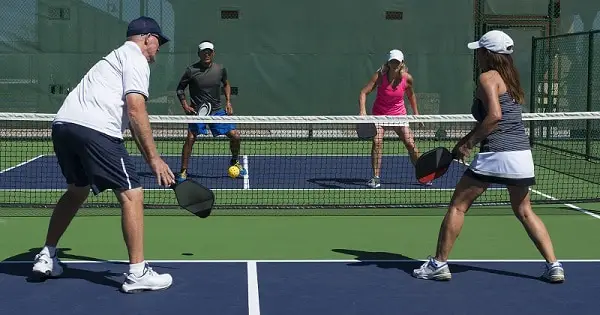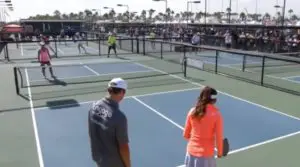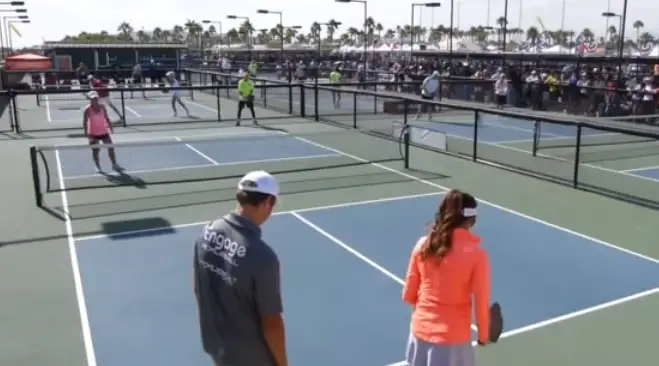One of the advanced pickleball strategies is stacking which is used in doubles. In the piece below we look at what is pickleball stacking, why is it used and some excellent tips to help you gain control over this tactic.
Let’s dig right in then.
Table of Content
What is Pickleball Stacking?
Pickleball stacking is a tactic used in doubles play whereby players in a team aren’t in a traditional position but ‘stack up’ on the same side of their side of the court to gain some sort of an advantage over their opponent.
Typically, or traditionally, whether serving or returning, pickleball players position themselves in their own quarters on the court, as can be shown by the picture below.

However, in case of the stacking strategy, two players from the same team will start off by standing on the same side of the court, typically at the start of the rally and then depending on how the rally goes forward they will move to their traditional positions.
Also Read:
When is Stacking Used as a Strategy?
 Typically stacking is used by pickleball doubles teams which contain a player who is right-handed and the other who is left-handed. It is more commonly used by the serving team.
Typically stacking is used by pickleball doubles teams which contain a player who is right-handed and the other who is left-handed. It is more commonly used by the serving team.
In such a scenario, the right-handed player plays from the left side of the court and the left-handed player plays from the right side, thereby ensuring the middle of the court is covered by the forehand of both players.
However, what happens when the right-handed player is serving from the right side and in the traditional strategy, the left-handed player is on the left side of the court is both players have their, typically weaker backhand in the middle of the court.
In order to change that around, the two players stack up on the same side with the right-handed server rushing to the right side of the court after serving while the left-handed, non-server takes his/her position on the right side of the court.
In rare instances, this tactic is also used by players who play with the same hand but with at least one of the players having a very strong backhand to go with it too.
Here’s a list of possible occasions when the stacking strategy can be used in pickleball.
Different-Handed Players in the Same Team
This is one of the most common reasons for using the stacking strategy in pickleball.
As explained in the section above, if a team has a left-handed and a right-handed pickleball player, stacking will be used when the right-handed player is serving from the right side or the left-handed player is serving from the left side of the court.
Same-Handed Players with One Better Backhand
If both players are either left-handed or right-handed, then the stacking tactic might not work too well – in fact could cause more harm than good – unless one of the players has a very strong backhand.
In this case if the player with the strong backhand is serving from the left side, or the player with the weaker backhand is serving from the right side, it could make sense to try out stacking.
Mixed Doubles
Some like to use this tactic in amateur-level mixed doubles where a perception might exist that the woman’s backhand isn’t as strong as the men’s backhand. This wouldn’t be true on a lot of occasions frankly and as we have seen in a sport like tennis too, women players like Justin Henin who have a brilliant backhand, better than some of the top male players.
Player Has a Remarkably Better Reach
Some players have a better reach than others and if you are paired up with someone who has an excellent reach – or if you do as compared to your partner – it might be a good strategy to try out at times.
Stacking While Receiving in Pickleball
Teams can also use the stacking strategy while receiving as well.
In this case, if the right-handed player is receiving from the right side of the court then his/her left-handed partner can be on the outside of the right side of the court.
Once the return is made, the right-handed receiver can move to the left side while the left-handed player can take over the right side of the court.
At times, receiving players can opt not to stack together on the same side of the court but still exchange positions after the return is made.
How this would work is the receiving team would position them in a traditional manner but the non-receiving partner will signal to the receiving player of his/her intention to swap positions after the return is made.
Also Read:
Legality of Stacking in Pickleball
Is pickleball stacking a legal strategy? Yes, stacking is allowed in pickleball and the chief reason behind this is there is no rule which instructs where a player can stand during a doubles match except while serving the ball and receiving a serve.
Other than the player completing his/her serve and the returning player completing the return of serve, nothing prevents players from where they want to stand on their side (cannot obviously jump over the net to the other side!), including in the kitchen. Obviously cannot hit a volley in the kitchen.
In other words, pickleball service rules describe which player must serve and from which side of his/her court and which player must return, and from which side of his/her court.
What is not described in that rule-book is where the other players involved in the doubles game can stand and who can play the next shot after the ball has been returned (unlike in table tennis where the order of shot-making is pre-defined).
Other Things to Remember While Using Stacking
Here’s something to remember if you have gotten this far and are looking to use the stacking strategy.
- Some basic advice. Since stacking is typically a more advanced tactic, if you are using it as a beginner, make sure to ensure you don’t confuse where to start your serve from; i.e. don’t forget the basic serving rules.
- Secondly, make sure to practice the stacking strategy thoroughly before using it in a match. While in theory it is not too difficult to understand, you need to ensure you have the nuts and bolts of the tactic running beforehand.
- You don’t need to use this tactic for every point. For one, when the left-handed player is on the right side and the right-handed player is on the left side of the court, the team is already in the right position to control the middle of the court.
- Even when the players are positioned in such a way that they aren’t controlling the middle of the court, there could be a mix and match of using this tactic. This ensures the opponent doesn’t get used to this and it also keeps one’s weaker shot, the backhand in the game.
- The other reason to not stack every time is if one of the players isn’t as fit or nimble. Consistently stacking in this case could nullify its advantage in such a case
- In the aforementioned case, a 3/4th stacking can be tried out; i.e. stacking every time during serve and only half the time during returns.
- Stacking is more common while serving than on return but that doesn’t mean it cannot be used while returning.


